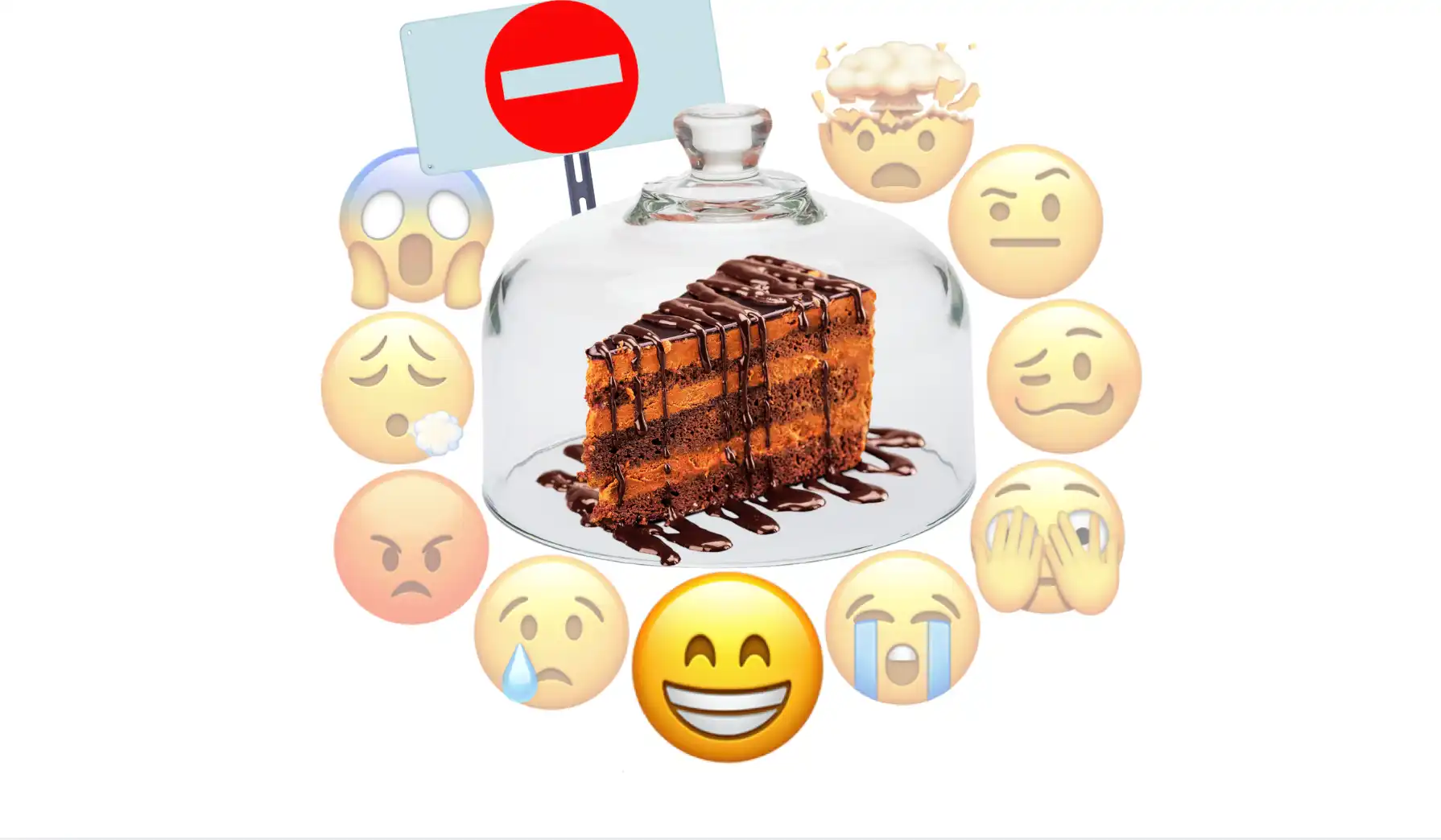Your False Belief Is the Only Cause of Your Unhappiness
You might think you understand the cause-and-effect principles that govern the universe, the fundamental laws underlying all creation. Or perhaps you believe in a creator and its creations and have some knowledge about that. Regardless of your beliefs, most of us agree that things don’t happen without a reason. Everything around us has underlying causes.
If we take a moment to study this, we should all arrive at the same conclusion.
However, if you have truly internalized this principle, you would never place your happiness outside of yourself. You wouldn’t rely on others or external factors for your happiness. While you might depend on them for a comfortable and convenient life, they wouldn’t affect your mental well-being. Similarly, you wouldn’t blame others or external circumstances for your unhappiness.
Why?
Because such false belief completely contradicts the very principle of cause and effect.
This contradiction is the only barrier between you and unconditional happiness.
In this article, we will explore why this view is fundamentally opposed to nature and how internalizing an understanding of cause and effect paves the way to true freedom.
I invite you to think critically about what you’re going to read. You will encounter some statements that may initially sound counterintuitive or even absurd. However, if you analyze them thoroughly and objectively, you will come to understand that they are true at their core. This is not because I, or anyone else, says so, but because you can—and indeed should—verify this for yourself.
The profundity of a candle flame
Let’s start off with something relatively easy to understand, yet incredibly profound and practical at the same time: a candle flame.
How does a candle flame arise?
Before you say, “You just light it with a matchstick or a lighter”—which is precisely what I would have said before—take a moment to think about what causes are needed to produce a flame. Think about the flame as an effect. What do we need to get this particular effect?
Why does a lighter or matchstick aid in creating this result?
Because it introduces a cause: a high enough temperature. Although an average flame has a temperature of over 800°C (1472°F), the ignition temperature of an average candle wick is only 150-200°C (300-400°F). But that’s just one cause. What you are trying to burn, in this case, the wax (via the candle wick), needs to be flammable.
That’s another cause: a flammable object.
And without oxygen, nothing would ever burn, so that’s the third cause.
We only need these three causes coming together to give rise to the effect of a candle flame:
- High enough temperature (150-200°C or 300-400°F).
- Flammable material (candle wick + wax).
- Oxygen.
We don’t need to go deeper than this. We don’t need to become physicists.
Here’s a video that goes a little deeper if you’re interested.
Now, it may seem that once ignited, a flame burns, and we can sit back and relax.
Well, yes…
And no.
For as long as a flame burns, what we can be absolutely certain of is that those three causes are present every single moment.
Think of a flame like a campfire. When you put wood on the fire, it keeps burning because the wood provides fuel (along with a high temperature and oxygen). Similarly, when you light a candle, the melted wax acts like the wood—it’s what keeps the flame going. Just like adding more wood to keep a campfire burning, the candle continues as long as there’s wax to fuel it.
Of course, oxygen needs to be present as well, which is easy to test for yourself.
What happens when we cover a flame with a jar or glass? Within seconds, the oxygen decreases low enough for the flame to no longer manifest since one of the three causes is missing.
What happens when you sprinkle a few drops of water on the flame? The temperature lowers. If it drops below the ignition point, one of the main causes is no longer present, and the result changes accordingly.
The same goes for when you blow a gust of wind: it reduces the temperature, potentially removing the cause of a high enough temperature needed for the flame.
Similarly, if you take away the flammable object, the flame will extinguish because one of the essential causes is no longer present.
This is how firefighters sometimes operate when fighting forest fires; instead of using water, they burn the surrounding flora to prevent the fire from spreading further, i.e., they simply remove one of the causes.
The result is that the three causes needed to manifest a flame no longer come together. To put it simply: there’s no flame.
Why do we care about all of this? Because there’s a very important connection to our happiness. However, neither we nor even physicists never stop to think about this, which is why so many of us are dependent on external things for our happiness. Ironically, this leads us to be in a constant state of searching, which is inherently dissatisfying and vexatious, as explained in the articles on pleasure and vexation.
This is crucial to understand when we analyze our state of mind and how we view the world. If you haven’t read those articles yet, I urge you to do so; otherwise, you won’t get the most out of this article.
The key points so far are:
- An effect can only ever result when the causes that lead to that particular effect are present or come together every single moment for as long as that effect manifests.
- The moment one cause ceases to exist, the previous effect can no longer manifest.
- Any effect or result is always the outcome of corresponding causes.
- Whatever the cause or causes, they always lead to a corresponding effect.
When you blow out a candle, there may be no flame, but there is still an effect. There always is, at any given moment. What you see, hear, smell, taste, touch, and perceive is always based on underlying causes.
Here’s a question:
When the three causes needed to produce a flame come together, what are the chances of a flame manifesting?
60%, 70%, 80%, 90%, or perhaps 99%? Or would it vary depending on other factors?
What do you think?
Causes always lead to corresponding results. We have no choice in the matter. So, whenever a flammable object, a high enough temperature to ignite that object, and oxygen come together, there is a 100% chance of a flame manifesting. It cannot be any other way. Nature simply works this way.
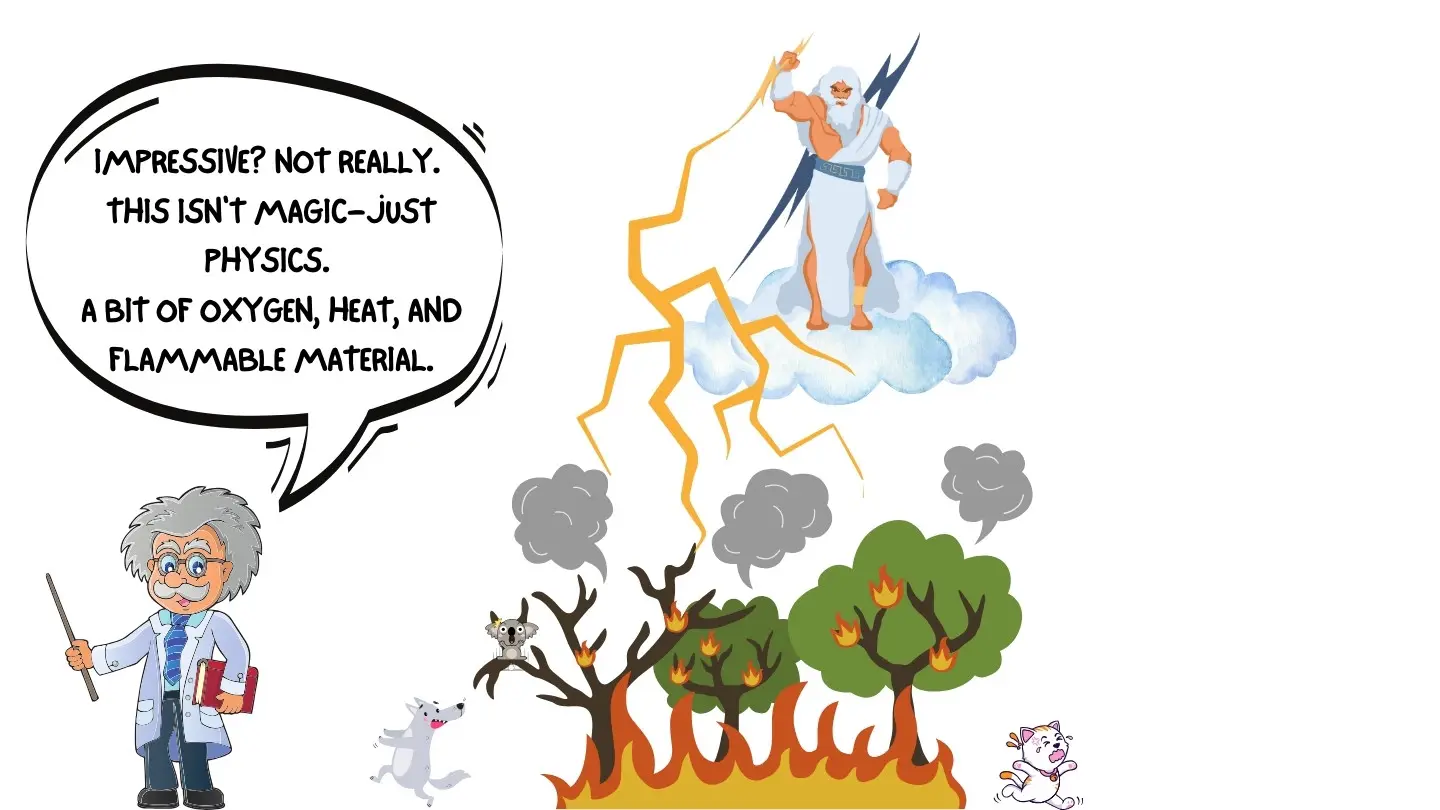
If Zeus were among us and wanted to start a fire, he could shoot a lightning bolt down to earth and cause a whole forest to go up in flames. Yet, the fire didn’t start because Zeus wanted to.
It started because there was enough heat generated by the lightning bolt, there were trees that could burn, and there was plenty of oxygen around.
Unless there’s a cause present that hinders these three from coming together, you can’t stop the effect from manifesting. You can add water, but by doing that, you decrease the temperature and effectively remove a cause.
You can add all sorts of chemicals to the wax, such as with scented candles, but they don’t prevent any of the three causes from coming together. And so, a flame continues to manifest.
Let’s say a chemical was accidentally added to the wax that would prevent the wax from being absorbed by the wick.
Then, it’s not actually the chemical itself that’s the cause for the flame not to arise; it is simply that the wax, which is the flammable material, is not able to mingle with the other two causes. This is the way we should look at it and understand it.
Now, let’s say Zeus regrets having set the forest on fire and he wishes to extinguish it. With all his powers, this is an easy task. But even though he is an almighty god, he still cannot wish the fire out. Well, perhaps he can, but the wish itself is not going to change anything.
However, if he wishes for one of the causes to cease, then he will be successful. In this case, he’d probably just lower the temperature enough, because removing oxygen would kill all life forms, and removing the flammable objects means taking all the trees and plants away.
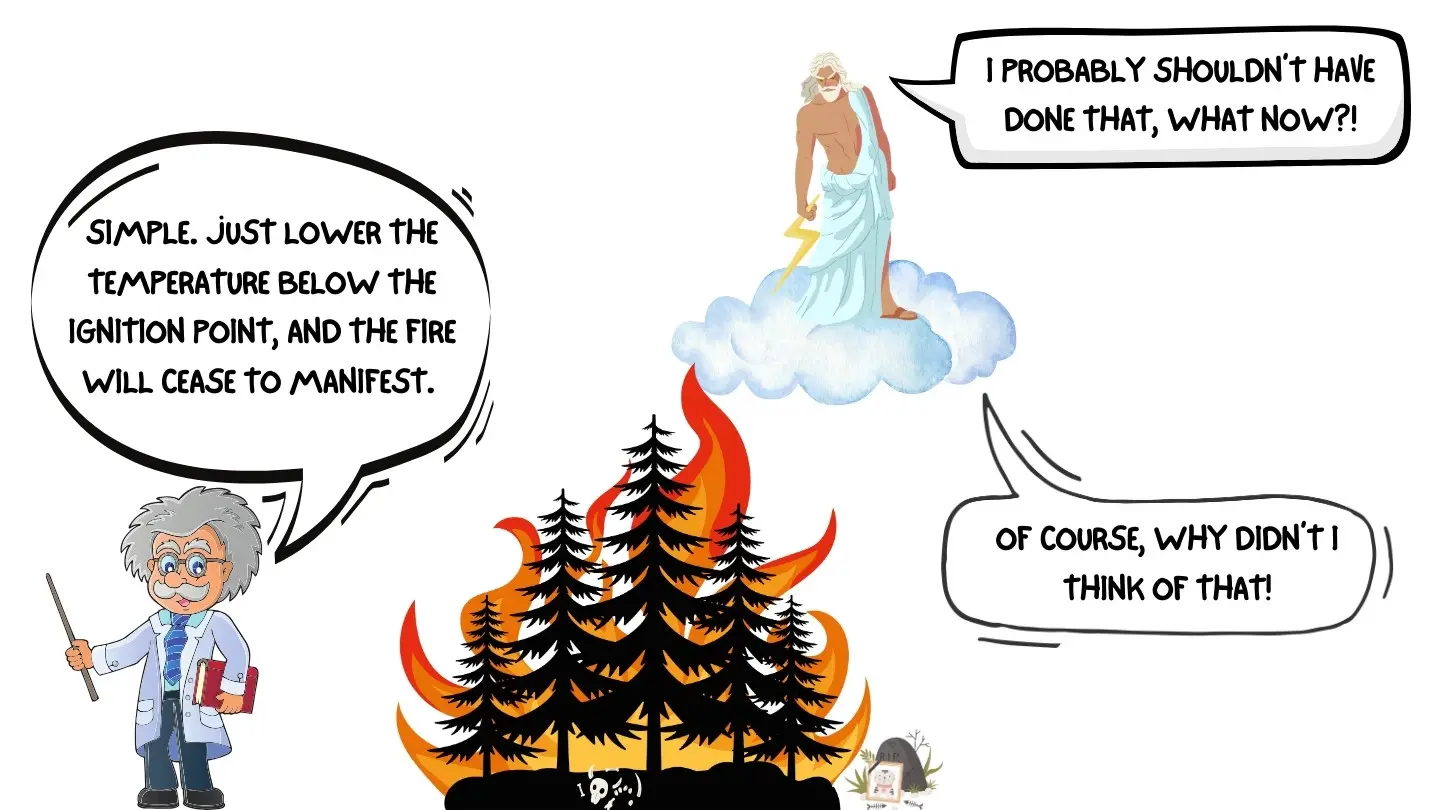
The science of a seed
A flame is just one example, but think about everything else you know. Look around you. Listen. Smell. Eat. Feel. Think. Everything is an effect with particular underlying causes.
Not everything is as clear-cut as a flame, but the principles always remain the same. Take the example of a seed.
How does a seed grow?
It needs the right environment to grow.
If a healthy seed receives enough nutrients, water, and sunlight, it is guaranteed to grow.
If a seed doesn’t grow for some reason, it’s not magic. We simply know that the causes don’t align for growth, or the effect, to happen.
Take two healthy seeds and plant them in exactly the same environment.
Say that 10 units of water provides the fastest possible growth. Seed A gets 10 units of water every day.
Seed B gets only 5 units.
What are the chances that Seed A grows faster?
As long as everything else is identical (i.e., all other causes are the same), the chances of Seed A growing faster are 100%.
Seed B might still grow, but its growth, the effect, is based on its corresponding causes. In this sense, there’s no such thing as Seed A doing better than Seed B. They both are simply the effect of underlying causes. Since the causes are different, the effect is different as well. That’s all that’s going on. The feeling of good and bad is simply the result of a hope or expectation being or not being met.
Expectation arises due to attachment, which in turn arises from the wrong perspective or perception you have of the world, which we’re addressing here (at least from one perspective). Although I usually use the terms “perspective” (or view or belief) and “perception” interchangeably, to keep it as simple as possible, it would be beneficial to start making a distinction between the two. Your perspective, or view, of the world determines how you perceive it.
That means your beliefs, or views, are one of the causes for the effect of perception to happen. I say one of the causes because to perceive sense inputs, you also require senses. A blind person can perceive many things, but sight is not one of them.
A good example to illustrate how your views influence your perception is that of someone who holds the belief that people from certain races or ethnicities are inferior in some way. The moment they see such a person, they perceive them as inferior. Perception is a thought process, and so the thoughts that arise are negative ones.
The stronger the views, the more pronounced the perception will be. In this case, if they hold very strong views, upon having to deal with people from other races or ethnicities, they might even generate hatred. Not because they want to—wanting has nothing to do with it. It’s simply the result of causes. It is simply because of the view they hold.
The only way to change this is by changing the view. Although this is very unlikely to happen overnight, in a life-threatening situation where their life is saved by one of those people, it could drastically alter their view. As a result, perception changes, and the thought process changes.
The thoughts that are now generated are different because they are an effect of corresponding causes, and one of the causes (the view) has changed. The effect (perception) can therefore not be the same as before. This isn’t magic; just nature.
To come back to the seeds: Seed A’s growth differs from Seed B’s growth because the causes are different.
What happens if we decide to give Seed A 20 units of water from now on instead of 10?
The effect will also change. Perhaps it will grow more slowly. Perhaps it won’t grow at all. Or perhaps its immune system will weaken, making it vulnerable to external influences.
Remember, the health of the seed is one of the causes needed for the seed to sprout and grow.
If we wish the seed to grow as fast as possible, we need to align the right causes, but also in the proper amount and in the right order. That’s why you put all four legs of a chair below the seating area, and not, let’s say, on the backrest.
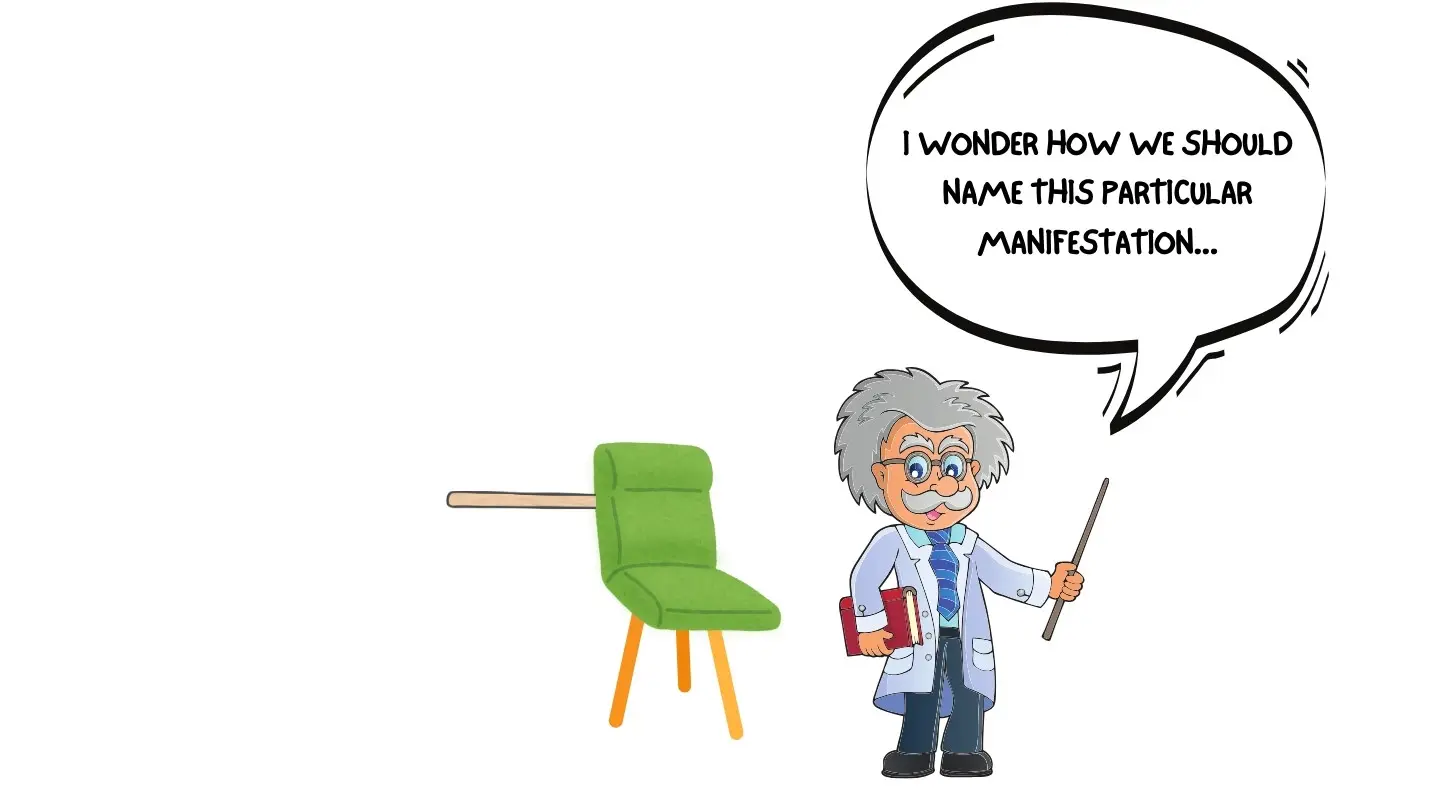
Although it may sometimes be hard to figure out what the right causes are, the principle remains the same: you cannot get a result that is not in line with the underlying corresponding causes.
We know this all too well in regard to the human body. The human body is also a prime example of cause and effect. That’s why, when you have an illness and don’t know the causes, it can be hard to treat the disease.
However, once the causes are known, you can change those and, in return, change the effect. Because once you change a cause, the effect will change accordingly. What are the chances again for this? The effect is going to be different, 100% guaranteed.
If you know that you are allergic to a certain food and it keeps giving you a rash, simply by eliminating that food, you have eliminated a cause of your rash, and it will never come back. You don’t need to apply any ointment.
“You” are not the cause
To light a candle, does it matter who lights it?
If there’s a candle, a flammable object, and someone lights it with a working lighter, would there be any reason for them to fail?
If their muscles and nervous system are functioning properly, every single person is going to succeed at creating a flame. This is because it has nothing to do with the person lighting it; all that matters is aligning the specific causes to manifest the corresponding result.
Imagine you’re at home and have invited a few friends over. In front of you is the TV remote. Does it matter who presses the “on” button for the TV to switch on? When all the causes align, it doesn’t matter who or what presses the button. Pressing the button activates the circuitry needed to turn on the screen.
The circuitry being switched on (whether via the remote or the TV itself) is one of the main causes. As long as this cause and the other necessary causes align (screen intact, electric charge, signal, etc.), the TV will turn on because that is the effect. It doesn’t matter how it happens—even if a large enough insect flies in and hits the button hard enough, the TV will still turn on. So, specific causes that come together in a particular way and order always result in corresponding effects.
Let’s say you want to sit down, but the chair is a meter away from you. Do you first attempt to sit down or first take a step towards the chair? You can attempt to sit down, but the result will be you sitting on the floor. So, the order in which the causes align is important as well. We won’t delve further into that now, but it’s good to keep in mind.
How does this relate to happiness?
We have discussed how our happiness is nothing more than the relief of pressure building up in the mind. But we don’t feel it like that.
So let’s see how cause and effect applies here.
At what point do you feel good when you eat cake?
Take two people: one who wants cake and one who doesn’t. I’m not talking about a person who refrains from eating cake because they want to manage their weight, yet deep down wishes they could still have some cake. No, I’m talking about someone who really doesn’t enjoy cake.
So, one person wants it, and one doesn’t. A cake is placed in front of them. Who is going to enjoy it?
The person who wants it, of course.
Think about this yourself for a moment. Use cake as an example, or use another item of food that you like if you’re not into cake.
At what point do you feel good when you eat something, and why do you feel that way?
You can only ever feel good when you WANT to taste or eat it, or when you have a desire to experience a certain flavor. Without it, you cannot enjoy it. (In a future article we will discuss why sometimes one might feel guilty after eating something leading to seemingly conflicted emotions).
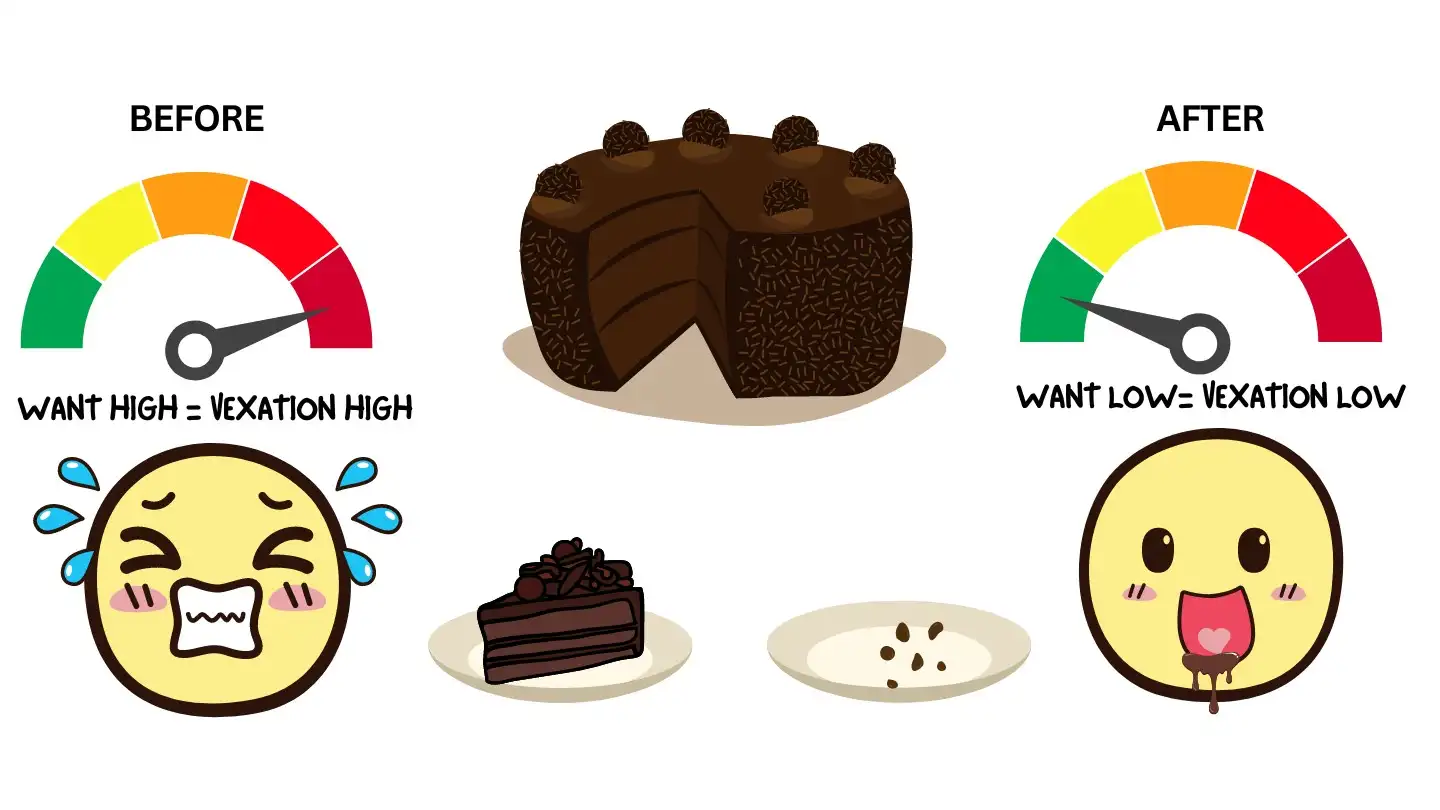
Say you’re eating cake, and you’re really enjoying it. Somebody asks you, “How’s the cake?” “Great!” you utter in response.
“How do you feel?” they continue.
Since at that moment you are enjoying, you naturally respond, “Amazing!” Then, they ask you another question,
“Why do you feel good?”
You simply point at the cake. You point at the cake, implying that the cake is the reason for your moment of joy.
You can’t help but feel that the cake is a cause for your momentary happiness during that time. Since you and the cake are both a part of nature and nature—you both are an arrangement of the same atoms that came from the soil—operates according to the principle of cause and effect, we need to be able to verify whether that can really be true.
The same causes coming together will always produce an effect that is in line with those causes. ALWAYS. There is no exception. Nature is incredibly consistent and fair. If the effect is different, that means the causes are different.
If cake is a cause for joy, then three things need to be true:
- It should provide joy for every single person. Just like every person with a lighter can produce a flame, nature doesn’t differentiate. Have you ever heard of nature saying, “Everyone can light a candle, except for people living above the equator at 1,000 m above sea level”? If cake were truly a cause of joy, it would work the same way for everyone.
- You should always feel joy the entire time you’re eating cake. As long as the corresponding causes come together, the effect keeps manifesting. For example, as long as wax (including the wick), oxygen, and a high enough temperature are present, a flame will continue to burn. Similarly, if cake were the cause of joy, eating it should always make you feel good without exception.
- You should enjoy cake every single time you eat it. Have you ever seen nature change its mind and suddenly require a slice of bread instead of oxygen to create a flame? These laws don’t change. Similarly, if cake were a true cause of joy, you’d never tire of it—you’d crave it every day, at any time, without losing satisfaction.
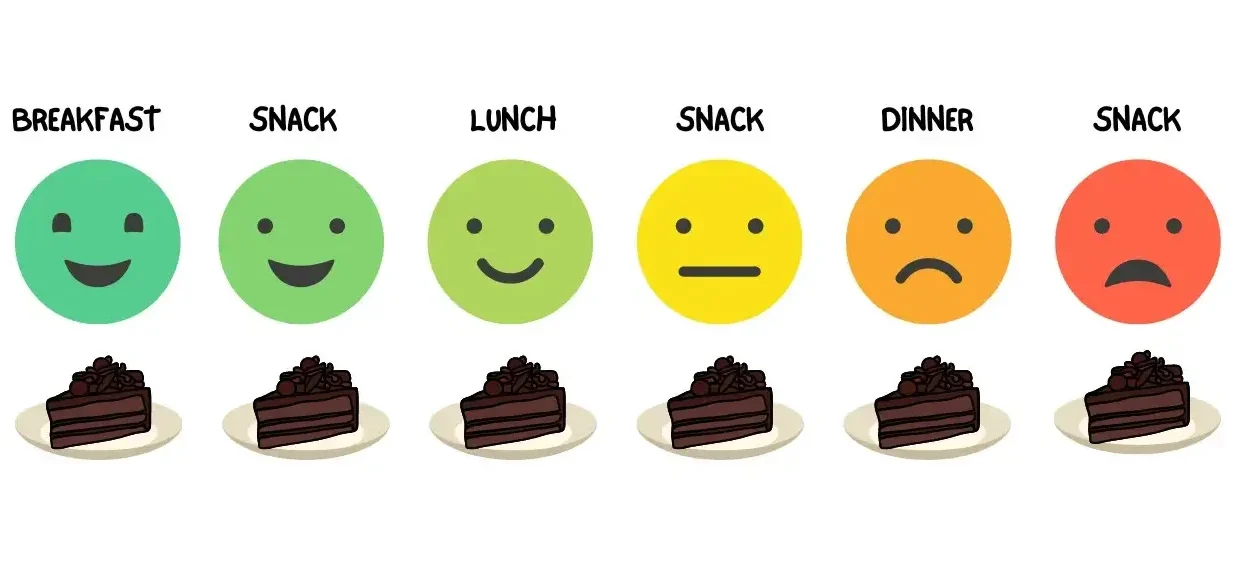
We know that the only reason you feel joy when eating cake is because you want it in the first place. You have a desire to eat cake, whether consciously or unconsciously. This is because you have a view that experiencing flavors contributes to your happiness, which manifests as an attachment and the desire to experience this flavor or another.
But what happens when you want that cake, but can’t have it? Let’s say it was served to a guest at a party, and it happened to be the last piece. So, there’s cake in front of you. You can’t touch it, but you still want it. Do you feel good now?
Of course not. You’ll feel restless and find it hard to focus on anything else.
When asked why you feel bad, you’ll say it’s because you can’t have that cake. Again, you’re pointing to something external, implying your uneasiness stems from not being able to have the cake. You’d even go as far as blaming the person who took the last piece or blame the one who offered it to them. You feel that the source of your discomfort is outside of you.
If not having cake is truly a cause of uneasiness, then several things should also be true:
- Everybody should feel bad when they don’t have cake. Since causes lead to corresponding effects, the same causes cannot lead to one effect one day and a different effect another.
- You should always feel bad if you can’t have more cake. Even after eating your fill, you should feel disappointed if there’s no more cake available.
- You wouldn’t feel satisfied eating anything else. If not having cake were the cause of dissatisfaction, then you should never feel content eating other foods. Yet, in reality, you eat many things besides cake. If at any point you feel satisfied with something else, it proves that not having cake isn’t a cause of your unease.
Having a false belief of the world is the true cause of all your problems
The cause of your mental discomfort has nothing to do with having or not having cake. It’s about wanting a cake and not having it, or not wanting a cake and then having it. You can’t help but point the finger at the wrong causes.
Your desires and expectations are the cause of your suffering. These, in turn, result from the views and perspectives you hold.
As discussed in How Your Attachments Suffocate You and The Hidden Stress Within a Moment of Joy, the reason you have desires is because the mind has an image or mental framework of what constitutes happiness. It is attached to these images and projects them onto the outside world continuously.
These images are created because of the view that the causes for happiness lie in the outside world. The mind then perceives happiness to be there. As a result, it is always in a state of searching. That search is vexatious. The longer the search continues, the more that pressure or vexation builds up.
But once you come across an object that meets those fabricated images, the mind experiences relief. It then points to the object and reinforces the idea that it is the object that provided happiness. This is a complete illusion. An utter lie. If there were no expectation to experience those objects, there would be no vexation in the first place.
The happiness we experience as a result is a mental fabrication. This is the only reason we cannot experience unconditional happiness. Really think about this. Don’t just take my word for it; analyze it objectively and see if it’s not true.
This is why you are always scratching that rash and believing that it is the scratching that makes you feel good, while not realizing that you can’t feel good without first experiencing discomfort. The only remedy is to remove the causes of the rash, not just scratch it.
Drinking salty water when you’re thirsty may feel good because it temporarily relieves your thirst. But does it actually solve the problem?
Imagine you are a doctor and a patient comes to you with a chronic headache. The patient takes paracetamol whenever they have a headache. You run some tests and discover they have a tumor in their brain. Would you send them home with a few more packs of paracetamol, or would you address the real problem?
Addressing the root cause of the rash, thirst, or headache is analogous to internalizing this knowledge. This changes the view at the root. Then, the mind won’t perceive happiness to be in any external thing. Then, it won’t seek happiness. When it doesn’t seek, it won’t be in a state of incompleteness or feel a sense of lack. That means it will be genuinely happy.
The outside world cannot offer any happiness. None of it is a cause for happiness.
If you are not convinced about this yet, just ask yourself:
“How do I feel when I am relieved of vexation, i.e., when I get what I desire?”
It feels amazing, right? That’s because your vexation decreased. But that vexation always returns, doesn’t it? Honestly, doesn’t it always come back sooner or later?
That’s why you keep eating this and that for your pleasure, why you keep going to parties, why you feel the need to go out and have fun, and why you keep traveling here and there. You keep listening to music during your drive or on your commute to work. You keep watching new episodes of shows on YouTube or Netflix, catching the latest movies, and so on. This list is endless.
Why you don’t want the same thing too often
The reason you have a limit for certain inputs—like having cake for breakfast, lunch, and dinner—is because the mind is trying to extract happiness from something that is inherently devoid of it. Cake is just a collection of carbon, hydrogen, oxygen, nitrogen, and other elements. These same particles form the foods you dislike. There’s nothing special inside any of them. Flavor is not even a part of them, although we won’t go over that right here.
That’s why the mind can get fed up with too much of the same thing. It’s like trying to flip an hourglass and expecting it not to empty. There’s a hole, so of course it will empty. With the wrong views of the world, you keep expecting the impossible. And expecting the impossible is the effect of the corresponding cause—that view.
When the mind believes it finds something, it gets elated. But that feeling cannot last because there is no elation found outside. The mind therefore creates this feeling all by itself, but it fades soon after because whatever the mind thought it found doesn’t actually contain any such thing.
That’s why the solution isn’t to keep trying to fulfill yourself. No one has ever succeeded in doing that, and no one ever will. That’s why every single person in their old age is still trying to be happy every day. They still rely on things to be happy, whether that’s family, a TV set, or a cup of tea. If any of those things are taken away, see what happens—vexation can no longer be relieved. When they are dying, don’t they wish for their loved ones to be around? Then that means they are still searching for happiness in the very last moments.
Now imagine not having any vexation at all. You know how it feels to experience a reduction of vexation—that’s the pleasure you feel whenever you get something you want. But imagine having zero vexation, none at all. Think about how blissful that would be. You only know how a relief of vexation feels; you don’t know how the absence of vexation feels.
To reach that state, you don’t have to let go of anything. You just need to realize and develop the understanding that you’re chasing delusions. When that realization deepens, your mind will gradually stop trying to extract happiness where it can’t be found, and it will be at a peace you’ve never felt before.
Understand this and be free. You deserve it.
Happiness and mindfulness exercise

Here’s the adjusted version of the last part of the passage to ensure it flows seamlessly into the bullet points you listed earlier:
Your understanding of the world is incorrect. The world operates according to the principle of cause and effect. Yet, whenever we feel sad, disappointed, frustrated, angry, empty, or depressed, our views, perceptions, and actions completely contradict these principles. We believe we know the causes of our emotions, but in reality, we’re always pointing at fictional causes.
We see things that aren’t actually there. It’s like walking in the desert, seeing a mirage, believing it to be water, and chasing after it. Do you want to keep pursuing illusions, or do you wish to find a real solution to this problem?
We need to train ourselves to see things as they truly are. Only then will this hopeless chase after illusions come to a stop.
To make this effective, take some time daily to reflect on these principles. Use any experience from your life, whether it’s a past event, something happening now, or a potential future scenario.
Whenever we feel happy or unhappy due to the events that happen around us, we need to examine whether the outside is truly the cause of our (un)happiness. If it were, we would come to the following conclusions:
- It should provide joy or misery for every single person.
- Example: Everyone should enjoy chocolate, traveling, or any universally desired experience.
- You should always feel joy or unhappiness the entire time “the cause” is present.
- Example: You should love doing your favorite hobby without ever getting tired of it.
- Example: You should always be happy when you are around your loved ones.
- You should enjoy or suffer every single time you encounter “the cause.”
- Example: You should always be thrilled to meet with your best friend, without exception.
- Example: You should always suffer when you see someone you dislike, even if they suddenly change and donate their entire fortune to you.
- You should always feel happy when a normally regarded unwanted cause disappears.
- Example: You should always feel relieved when a long traffic jam finally clears, even if it prevents you from having a valid excuse for being late to a meeting you weren’t looking forward to, or if it shortens some quality time you were having with yourself or someone else.
- You should always feel unhappy when a normally regarded wanted cause disappears.
- Example: You could never feel unhappy when you stop playing your favorite game, even after playing the whole day.
You need to be able to verify that none of these are actual causes of your happiness or unhappiness. If they were, there would be no inconsistency whatsoever; nature is perfectly consistent.
Therefore, the true causes of your emotional ups and downs lie elsewhere.
In every scenario, there is always an underlying desire and expectation for things to be arranged in a certain way—without exception.
Conclusion
Any desire or expectation you have manifests as a want. You want something because, internally, the mind holds the belief, view, or perspective that happiness must come from the outside. As a result, you can’t help but expect and hope that happiness will come from external sources because your views determine how you perceive the world, which, in turn, shapes your thoughts. The view or belief is the cause of perception.
This underlying view is, therefore, the root cause of any unhappiness you have ever experienced. Whenever this unhappiness or unwanted feeling is relieved, you feel joyful, and life seems amazing. Unfortunately, this elated feeling is an illusory happiness created by the mind in response to its internal expectations, which it projects onto the outside world. Everything and anything in this world is only a collection of atoms utterly void of happiness.
That’s why this feeling never lasts because there’s nothing to hold on, even if the external causes remain the same.
You don’t need to worry about changing your life; just focus on realizing how the world truly works. This is the only way to be truly happy and be free from suffering.

